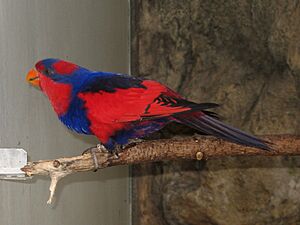Red-and-blue lory facts for kids
Quick facts for kids Red-and-blue lory |
|
|---|---|
 |
|
 |
|
| At Loro Parque, Tenerife, Spain | |
| Conservation status | |
| Scientific classification | |
| Genus: |
Eos
|
| Species: |
histrio
|
The red-and-blue lory (Eos histrio) is a small, very colorful parrot. It lives only in Indonesia, on a single island called Karakelong. This bird used to live on other islands too, like the Sangihe Islands and other parts of the Talaud Islands. But now, it's mostly found in just one place.
Contents
Types of Red-and-Blue Lories
Scientists recognize two main types, or subspecies, of the red-and-blue lory. Sadly, one of these types no longer exists.
- E. h. challengeri - This type lives on the Talaud Islands, mainly on Karakelong.
- †E. h. histrio - This type used to live on islands like Sangir and Siau. But it is now extinct, meaning it has completely disappeared.
The E. h. histrio subspecies likely died out because too many trees were cut down in its habitat. For a while, people thought the E. h. challengeri subspecies might also be gone. But in 2022, scientists confirmed it is still alive on the Talaud Islands.
What Does It Look Like?
The red-and-blue lory is about 30 centimeters (12 inches) long, including its tail. Both male and female birds look exactly the same, so it's hard to tell them apart just by looking.
This parrot has a short, curved, bright orange beak. The feathers near its nostrils are bright red. The top of its head is a deep purple, and the back of its head is red. The back of its neck is a strong violet color. A dark blue-purple stripe goes from its beak to the back of its neck.
Most of the bird's body is bright red. Its lower back and belly are a slightly darker red. Across its chest, there is a wide band of deep blue. The back of the bird is a deep violet-purple, matching the color on its neck. Its wing and tail feathers are reddish-violet. The feathers covering its wings are black and red with black tips. The feathers on its legs are bluish-purple. Its feet are gray, and its claws are black. The skin around its nostrils is very dark gray, and its eyes are dark brown.
The red-and-blue lory makes short, harsh, chattering screeches. When it flies, it is said to be very fast and fly in a straight line.
Where Do They Live?
The red-and-blue lory now lives only on the Talaud Islands in northern Sulawesi, Indonesia. Almost all of these birds live on just one island, Karakelang. In the past, some populations lived on other islands like Sangihe, Siau, and Tagulandang, but they have disappeared. The number of these birds is quickly going down.
These parrots live in forests from sea level up to about 1,500 meters (4,900 feet) high. The only place where their population can survive is on Karakelang. Even on that island, their groups are spread out in about four different areas. Because they live in such a small area, they are very easily affected by things that could make them extinct.
Life of a Red-and-Blue Lory
These parrots spend all their lives in trees. They do not look for food on the ground. Like most lories, they mainly eat nectar and pollen from flowers. They also sometimes eat insects and fruit. In the wild, red-and-blue lories are known to be loud and noisy. However, they become quiet when they are eating.
They need old, tall trees to build their nests. When people cut down these important trees, it threatens the birds' survival. A female lory usually lays 2 eggs. The eggs hatch after about 25 to 26 days. When it's not breeding season, these birds gather in groups, often in palm tree farms. They don't migrate, but they might fly between nearby islands to find food.
Most lories and lorikeets live for 10 to 15 years when kept by humans. So, scientists think the red-and-blue lory might have a similar lifespan, even though it's not fully known. It is very rare to find these birds as pets. Successful breeding of them has only been reported once in scientific records.
Protecting These Parrots
The red-and-blue lory is currently listed as an Endangered animal by the IUCN. This means they are at a very high risk of becoming extinct in the wild. They are also listed under CITES Appendix I. This means it is against the law to buy or sell these birds internationally if they were caught in the wild.
However, illegal trade still happens. About 80% of the birds caught illegally are sent to the nearby Philippines.
Many things threaten these birds. These include:
- Illegal trapping for the pet trade.
- Spraying insecticides on coconut farms.
- Logging, which destroys their homes.
- A disease called Newcastle disease that can spread from chickens.
Because of their beautiful colors, these parrots have been popular as pets in Indonesia and the Philippines since the 1800s. They have been trapped for trade since then. Luckily, trapping has decreased since the late 1990s. But laws meant to protect them are not always strongly enforced. These birds are fully protected by Indonesian law and by CITES. Even in their protected nature areas, logging still threatens them.
Out of the three types of red-and-blue lories, two are thought to be extinct. The last remaining type is also decreasing in number. There are only about 5,500 to 14,000 red-and-blue lories left in the wild.




